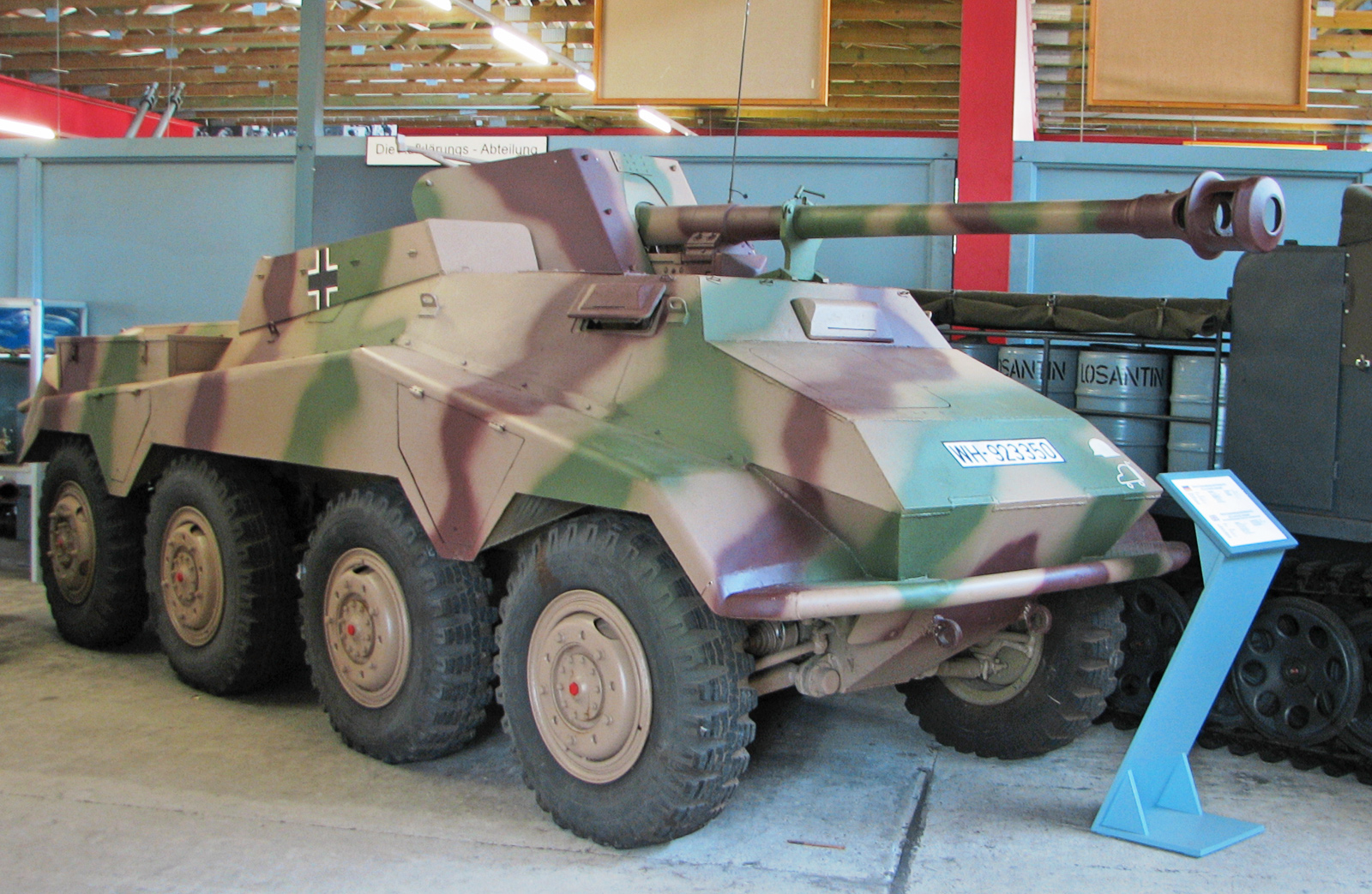
Germany’s Sd.Kfz.234 Eight Wheeled Armored Car
The Sd.Kfz.234 is one of Germany’s most fascinating vehicles of the war, and a rather unusual one for us as it doesn’t even have any tracks! It had eight steerable, independently sprung and powered wheels, a 220 hp air cooled diesel V12, highly angled armor, two drivers and a variety of guns ranging from auto cannons to literal anti-tank guns… yes, this thing is cool and yes, we want one.
All of these features weren’t just for show either, as it was not only a machine praised by Hitler, but one that possessed some of the best off-road performance of any wheeled vehicle during the Second World War.
In fact, it was so good that a few examples were used by Britain for decades after the war as a benchmark for much newer vehicles to be ranked against.
Background and development
The Sd.Kfz.234 was an excellent design boasting great mobility, a variety of weapon systems giving great tactical flexibility, and sufficient protection to fulfil its duties for reconnaissance tasking. The Sd.Kfz.234 was descended from earlier German armored cars which had performed superbly since the invasion of Poland.
One reason for the excellence of German armored cars during the Second World War was the Wehrmacht’s long association with wheeled armored platforms, and this was a result of the terms of the Treaty of Versailles. With the German Army forbidden any tanks or tracked vehicles, the German General Staff turned to armored cars early on for many purposes, with this research and development commencing shortly after the end of the First World War.
 A German Büssing A5P from the First World War. It had two drivers, one at the front and one at the back, as would later German armored cars.
A German Büssing A5P from the First World War. It had two drivers, one at the front and one at the back, as would later German armored cars.
The early campaigns in Poland and the West showed German faith in armored cars was not misplaced, with double and multi-axle platforms performing sterling duty as reconnaissance vehicles, particularly appreciated for being hard-hitting and fast moving.
With armored cars also performing as cavalry by exploiting local breakthroughs and attacking enemy rear areas causing much confusion, the general staff were impressed by the results provided by armored cars. Howeve, they also saw some design deficiencies that needed to be rectified.
In August 1940 the German General Staff initiated a project for a new design of a multi-axle armored car, that was similar in design to previous vehicles like the Sd.Kfz.231, but with thicker armor that also functioned as the vehicle’s chassis.
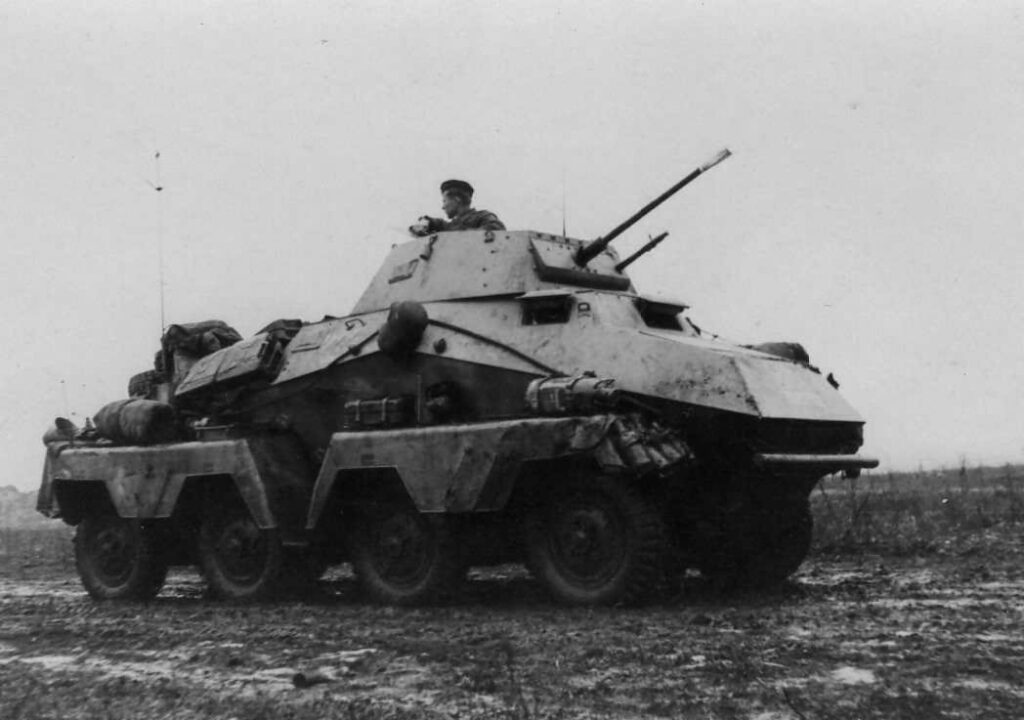 A Sd.Kfz.231 (8-rad) armored car, developed in the 1930s.
A Sd.Kfz.231 (8-rad) armored car, developed in the 1930s.
Overall capabilities were to be increased, and it was designed with tropical environments in mind. Armament was to be a 2 cm KwK 38, although a number of weapons would be used.
The project was handed to a conglomerate of German automobile manufacturers, and the first prototypes began to be assembled.
Trials on the first prototype commenced in July 1942, but serious vibration problems caused by the first choice of engine saw it replaced by a new air-cooled diesel, as the design was also envisaged to operate in a tropical environment.
The final design showcased an eight-wheel, four-axle vehicle, with all wheels having steering and power, providing great mobility. The vehicle had a driver’s position at each end of the crew compartment, which enabled it to be quickly driven out of danger at high speed without having to turn around and expose itself to hostile fire.
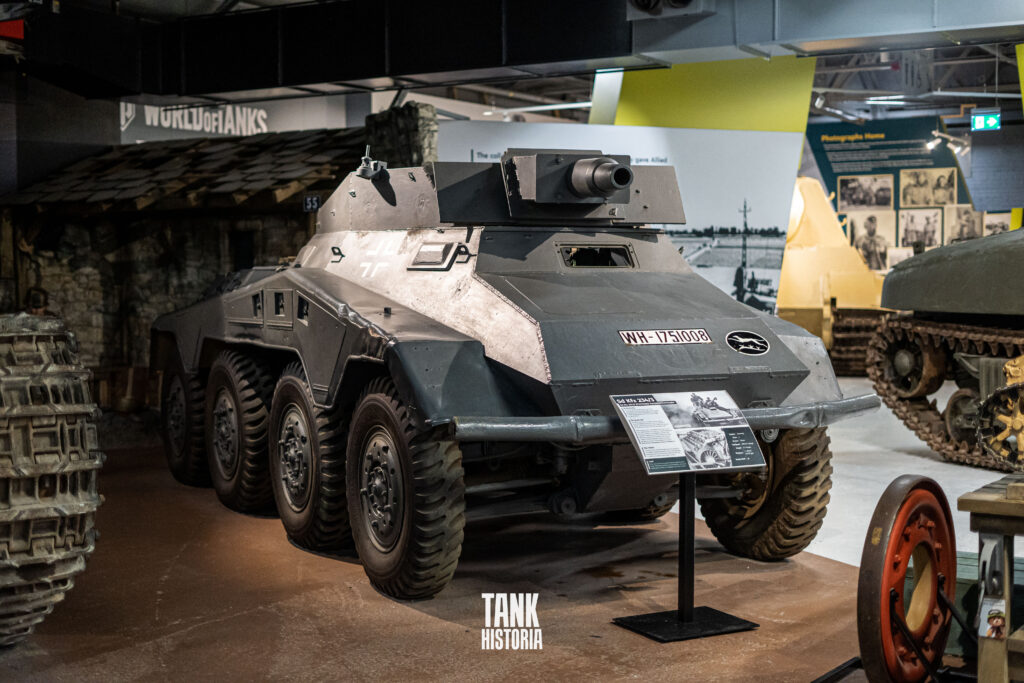 An Sd.Kfz.234/3 at The Tank Museum, Bovington. This example was used for decades after the war to compare newer wheeled vehicles against.
An Sd.Kfz.234/3 at The Tank Museum, Bovington. This example was used for decades after the war to compare newer wheeled vehicles against.
The Sd.Kfz.234 came in four variants over its production run from 1943 until the termination of hostilities, and a total of 478 examples were manufactured.
The first two models had rotating turrets mounting either a 5 cm gun or a 2 cm autocannon, while the final two models replaced the turrets with open superstructures. This was necessary as these variants were fitted with both short and long-barrelled 7.5 cm cannon, which could not be safely fired from a rotating turret.
Sd.Kfz.234
The Sd.Kfz.234 was a roomy design, and was appreciated by its crews for its habitability and operational efficiency, but the vehicle was about as compact as it could be with regard to its primary mission of armored reconnaissance. The 234’s hull was 5.9 metres (19 ft 4 in) long, 2.3 metres (7 ft 6 in) wide and 2.1 – 2.4 metres (6 ft 11 in) tall.
Fully combat loaded it came in at a weight of 11,000 – 12,000 kg (24,000 – 26,500 lbs), and had a crew of four; commander, gunner, driver and loader/reverse driver.
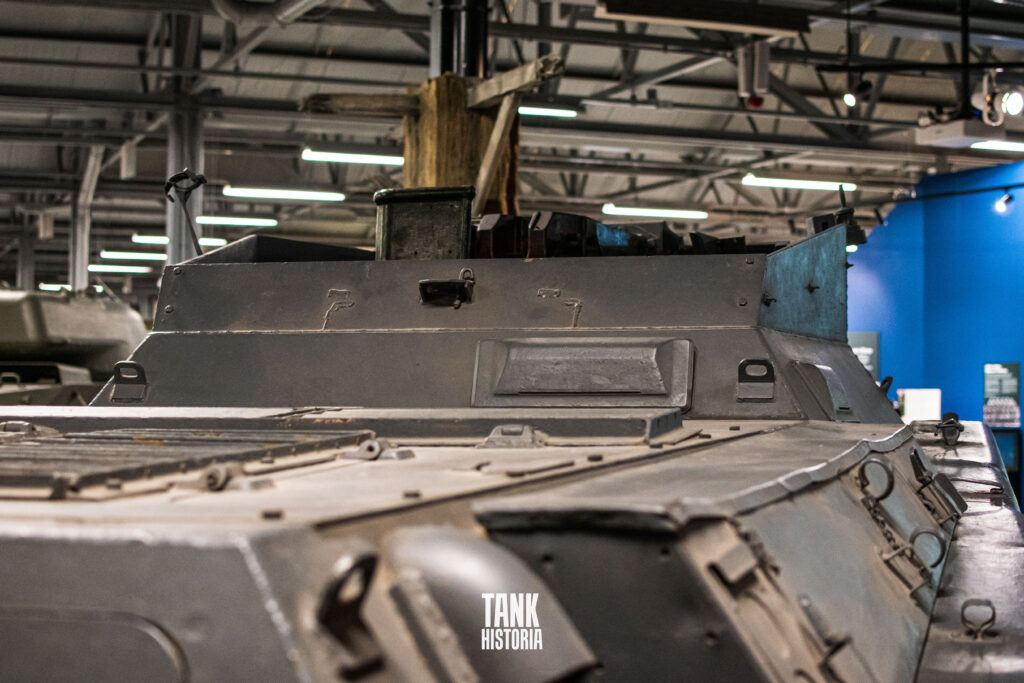 The rear-driver’s vision slit at the back of the fighting compartment on The Tank Museum’s example. The Sd.Kfz.234 had six forward and reverse gears, as well as a second drivers station at the rear. This meant it could drive as easily backwards as it could forward.
The rear-driver’s vision slit at the back of the fighting compartment on The Tank Museum’s example. The Sd.Kfz.234 had six forward and reverse gears, as well as a second drivers station at the rear. This meant it could drive as easily backwards as it could forward.
The 234 had armor plating varying from 9 – 30mm (0.3 – 1.2 inches) of face hardened, rolled homogenous armor (RHA), with the thickest plating protecting the frontal arc of the vehicle.
It was powered by a unique Tatra 103 V12 air-cooled diesel – the only German combat vehicle to have this power plant – as the platform was intended for tropical/hot weather use. This engine displaced nearly 15 litres (903 cu in), and produced 220 bhp.
 The 220 hp Tatra 103 air cooled V12 used in all models of the Sd.Kfz.234
The 220 hp Tatra 103 air cooled V12 used in all models of the Sd.Kfz.234
Driving a transmission with six forward and reverse gears, this drivetrain combination produced some impressive performance figures: a top speed of 50 mph (80 km/h) on flat surfaces, and a range of 620 miles (1,000 kilometres) on the road. It could also traverse 370 miles (600 kilometres) of rough terrain.
All wheels received power, and were sprung and steered individually with double wishbone suspension – quite an impressive feat for the era.
The Sd.Kfz. 234 Variants
The Sd.Kfz.234 came in four distinct variants, the armament of which being unique to each variant.
Sd.Kfz.234/2
The first production variant was the 234/2, which mounted the excellent KwK 39 5 cm L/60 cannon in a fully enclosed rotating turret. This weapon was also used in the Panzer III.
The 234/2 was fitted with an MG 42 as a secondary weapon, and 101 examples of this version were manufactured. It was initially known as simply the Sd.Kfz.234, before being renamed to Sd.Kfz.234/2 in early 1944. Production ran from November 1943 to June 1944.
 The Sd.Kfz.234/2, armed with a 5 cm KwK 39.
The Sd.Kfz.234/2, armed with a 5 cm KwK 39.
Sd.Kfz.234/1
The next variant was the 234/1, which had the 2 cm armament that had been planned from the vehicle’s inception. It had an 2 cm KwK 38 autocannon in an open-topped turret, next to an MG 42 coaxial machinegun.
Just over 200 units of this version entered service, with production running from mid-1944 to the end of the war.
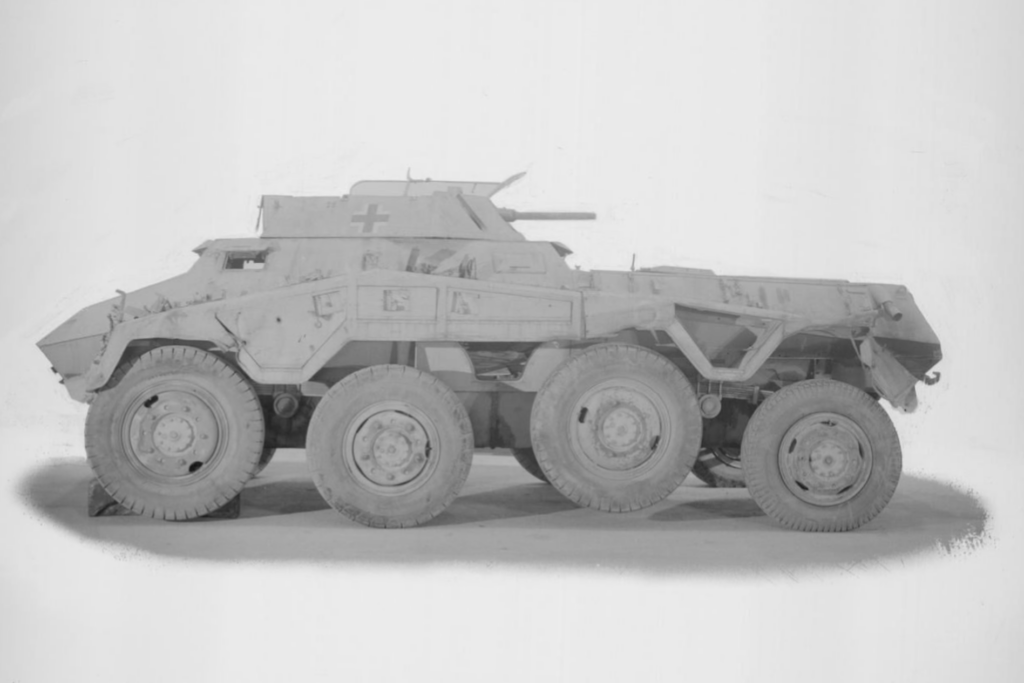 The Sd.Kfz.234/1, armed with a 2 cm autocannon.
The Sd.Kfz.234/1, armed with a 2 cm autocannon.
Sd.Kfz.234/3
The third variant was the 234/3, which traded a turret for a semi-traversable 7.5 cm Kanone 51 L/24. This was a short weapon that excelled against soft targets and structures, and the vehicle was intended to act as a highly mobile assault gun to support infantry and light mechanised forces
Production of this version began in mid-1944 alongside the 234/1, but it was stopped before the end of the year in exchange for the next type.
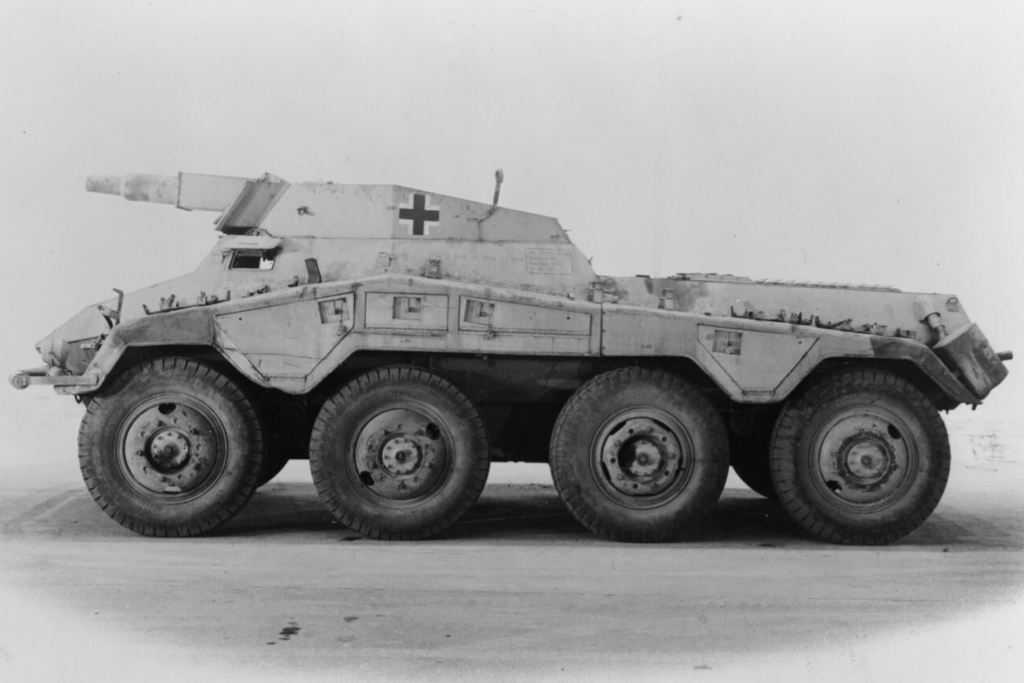 The Sd.Kfz.234/3, armed with a 7.5 cm Kanone 51 L/24 gun.
The Sd.Kfz.234/3, armed with a 7.5 cm Kanone 51 L/24 gun.
Sd.Kfz.234/4
The last variant of the 234 was also the most heavily-armed and arguably the most well known; the 234/4. It was armed with the formidable 7.5 mm PaK 40 L/46 high-velocity anti-tank gun in a bid to help combat the growing numbers of Allied tanks encountered from 1943 onwards.
This version came about after a meeting in late 1944, in which Hitler requested that such a gun be placed on the 234 chassis. Hitler was extremely impressed with the machine, but the powerful PaK 40 strained the chassis of the 234 to its limits, and only 89 examples were manufactured.
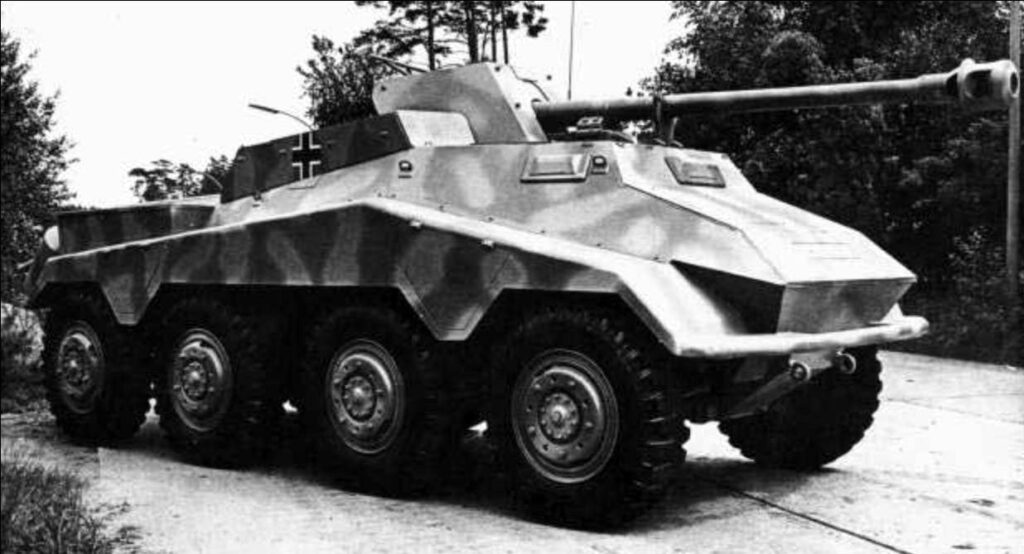 Sk.Kfz.234/4, armed with the powerful 7.5 cm PaK 40 L/46. The gun was protected by the same double 4 mm plate shield as the towed version.
Sk.Kfz.234/4, armed with the powerful 7.5 cm PaK 40 L/46. The gun was protected by the same double 4 mm plate shield as the towed version.
Service
The German Army was one of the most successful users of armored cars during the Second World War, with several superb designs boasting a great combination of mobility and firepower that excelled in the missions of mechanised reconnaissance and light cavalry tactics.
The Sd.Kfz.234 was in many ways the finest armored car of the war; well protected for its role, highly mobile and heavily armed, but its late introduction into service when the tides of war had swung against Germany, and the modest production totals of all variants ensured that this magnificent fighting vehicle never really fulfilled its conceptual promise.
The 234/2 was introduced into service just too late for the African service it was intended for, but served credibly in other theatres of operation.
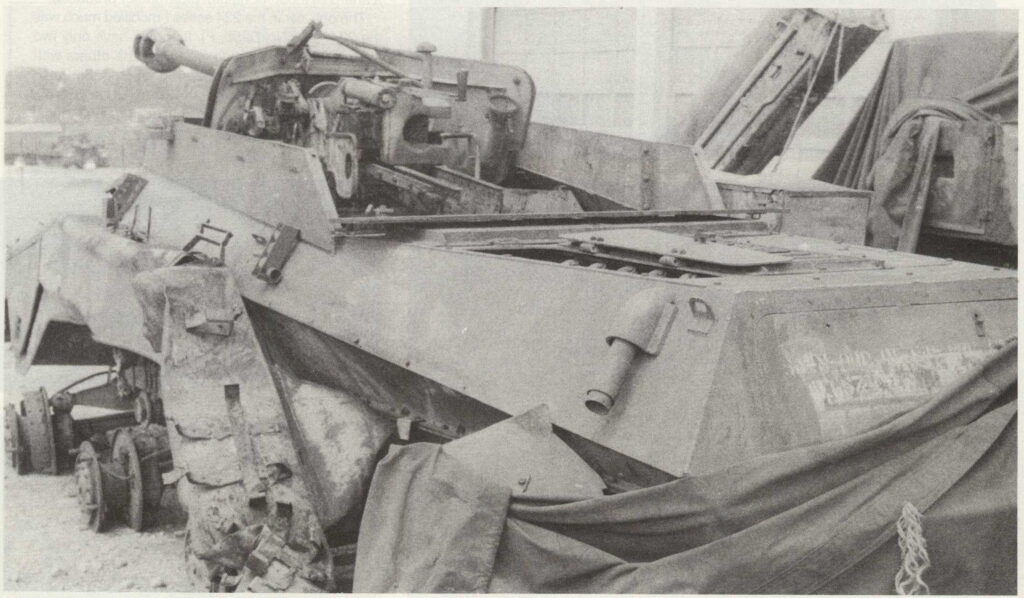 A knocked out Sd.Kfz.234/4. This image gives a good view of the gun’s working area.
A knocked out Sd.Kfz.234/4. This image gives a good view of the gun’s working area.
Distributed in small numbers to German armoured divisions and the 1LSSAH Panzer Division, the 234/2 soon found itself in combat on the Eastern Front, and by all accounts served with distinction in the mechanised reconnaissance role.
It was noted however, that the superb 50 mm L/60 cannon tended to influence crews into joining in armored combat, rather than concentrating on scouting work.
The 234/1 was produced in larger numbers due to cheaper manufacturing costs, but suffered from a lack of firepower, like all German reconnaissance vehicles armed only with a 20 mm cannon, and this variant was not as successful as the 234/2 in general service. This variant saw action on both fronts during the war.
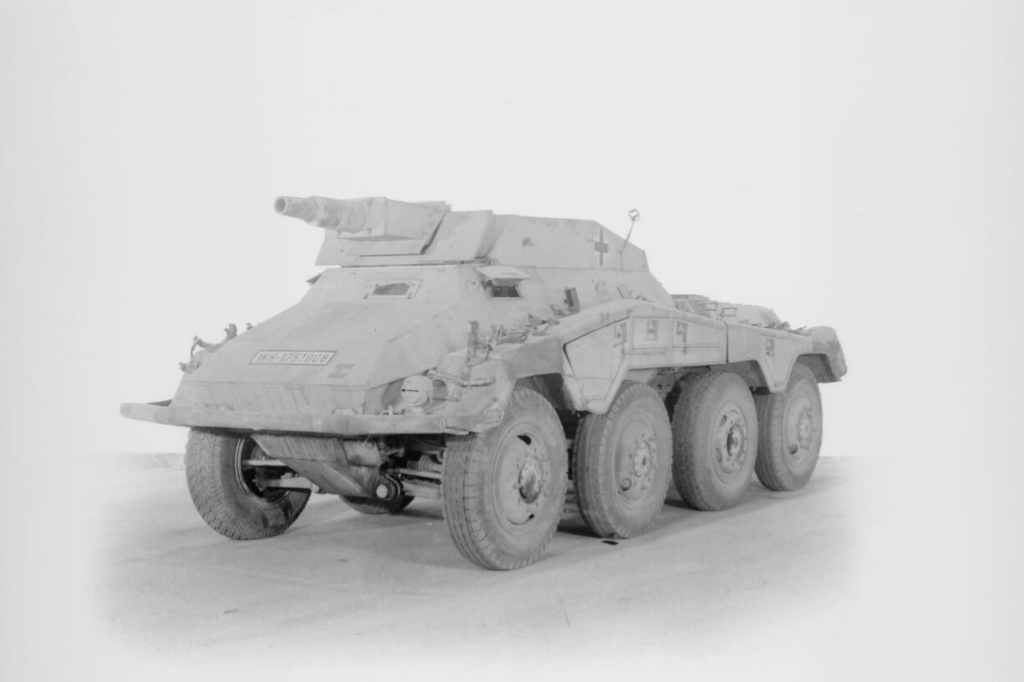 Sk.Kfz.234 after being captured by the British. The example in this image is now on display in The Tank Museum, Bovington.
Sk.Kfz.234 after being captured by the British. The example in this image is now on display in The Tank Museum, Bovington.
The 234/3 and the 234/4 variants were intended to address the growing shortage of German tanks, as wheeled armored platforms were easier and cheaper to manufacture compared to tracked combat vehicles.
Fitted with large-calibre cannons, these versions were designed to provide support to infantry units, and to supplement tanks in armored divisions. While both vehicles were excellent designs with ample firepower, their late introduction into service and the paltry numbers manufactured meant that they had little impact on the conduct of the war at this late stage.
All variants of the Sd.Kfz.234 were encountered by the Allies on both fronts in the European Theatre of Operations.
Survivors
Out of just under 500 built, there are only 3 complete Sd.Kfz.234s that survive today.
Sd.Kfz.234/3 – This example is located at The Tank Museum, Bovington. It was used for some time after the Second World War as a benchmark for later wheeled vehicles to be judged against, a testament to the Sd.Kfz.234’s excellent off-road peformance.
Sd.Kfz.234/4 – An Sd.Kfz.234/4 with the long 7.5 cm gun is located at the Deutsches Panzermuseum in Munster, Germany. This 234 was also used by the British for testing after the war, ending up in Bovington. It was eventually handed over to the Deutsches Panzermuseum in 1975, where it was restored.
Sd.Kfz.234/4 – The final surviving Sd.Kfz.234 is located at the U.S. Army Armor & Cavalry Collection in Fort Benning, USA. It was captured in Czechoslovakia in 1945 and shipped back to the US.
Conclusion
The Sd.Kfz 234 series of armored combat vehicles were perhaps the finest example of an armored car in service during the Second World War, and has had much influence on the design of wheeled armored fighting vehicles in the present day.
Unfortunately, the delays encountered in getting the platform into service, and the relatively modest totals of each version of the Sd.Kfz.234 eventually completed meant that the vehicle did not have the impact on mechanised warfare that its magnificent design mandated.
 One of only two remaining Sk.Kfz.234/4s. This one is located at the Panzermuseum, Munster. Image by 270862 CC BY-ND 2.0.
One of only two remaining Sk.Kfz.234/4s. This one is located at the Panzermuseum, Munster. Image by 270862 CC BY-ND 2.0.
It is an oft-repeated tale, and a sad indictment of Hitler and the German General Staff that many excellent designs for combat aircraft and vehicles did not receive the procurement priorities that they deserved, to the detriment of the troops fighting at the front.
The history of ground combat in Europe during the Second World War might have taken a different twist, had German troops been equipped with sufficient numbers of high-quality armored vehicles.
Several hundred or even some thousands of 234 series armored cars might not have saved Germany from losing the war, but definitively would have made the Allies’ task of conquering Germany far more difficult and dangerous.
News
The Hanging Temple: China’s 1,500-Year-Old Cliffside Marvel of Faith and Engineering
The Hanging Temple: China’s 1,500-Year-Old Cliffside Marvel of Faith and Engineering Perched precariously on the cliffs of Mount Heng in Shanxi Province, China, the Hanging Temple, also known as Xuankong Temple, Hengshan Hanging Temple, or Hanging Monastery, is an architectural…
The Willendorf Venus: A 30,000-Year-Old Masterpiece Reveals Astonishing Secrets
The Willendorf Venus: A 30,000-Year-Old Masterpiece Reveals Astonishing Secrets The “Willendorf Venus” stands as one of the most revered archaeological treasures from the Upper Paleolithic era. Discovered in 1908 by scientist Johann Veran near Willendorf, Austria, this small yet profound…
Unveiling the Maya: Hallucinogens and Rituals Beneath the Yucatán Ball Courts
Unveiling the Maya: Hallucinogens and Rituals Beneath the Yucatán Ball Courts New archaeological research has uncovered intriguing insights into the ritual practices of the ancient Maya civilization. The focus of this study is a ceremonial offering found beneath the sediment…
Uncovering the Oldest Agricultural Machine: The Threshing Sledge’s Neolithic Origins
Uncovering the Oldest Agricultural Machine: The Threshing Sledge’s Neolithic Origins The history of agricultural innovation is a fascinating journey that spans thousands of years, and one of the earliest known agricultural machines is the threshing sledge. Recently, a groundbreaking study…
Nara’s Ancient Sword: A 1,600-Year-Old Protector Against Evil Spirits
Nara’s Ancient Sword: A 1,600-Year-Old Protector Against Evil Spirits In a remarkable discovery that has captured the attention of archaeologists and historians alike, a 7.5-foot-long iron sword was unearthed from a 1,600-year-old burial mound in Nara, Japan. This oversized weapon,…
The Inflatable Plane, Dropped Behind the Lines for Downed Pilots
Experimental The Inflatable Plane, Dropped Behind the Lines for Downed Pilots The Inflatoplane from Goodyear was an unconventional aircraft developed by the Goodyear Aircraft Company, a branch of the renowned Goodyear Tire and Rubber Company, also famed for the Goodyear…
End of content
No more pages to load











